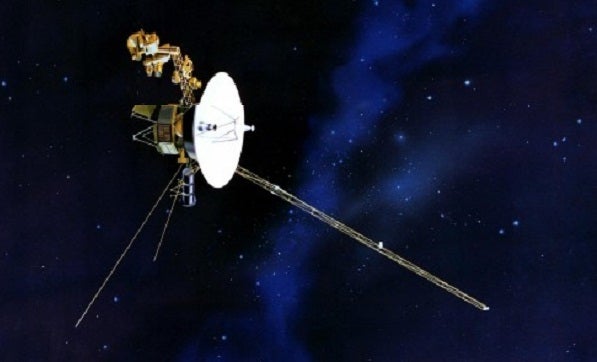Voyager’s last mission begins

Credit: NASA. An artist's image of Voyager 1, launched 35 years ago and still exploring the far-reaches of the solar system
At 11.5 billion miles from home, Voyager 1 is not only farther than the orbit of Pluto, it’s beyond the paths of Makemake, Quaoar, and Varuna – worlds we didn’t even know existed when the sturdy spacecraft was launched in 1977. Those distant bodies were briefly considered new planets until scientists found so many they decided to create a new category of solar system object into which they re-categorize Pluto.
And yet, from its unfathomable distance, Voyager is still beaming back new scientific information. For the last several years it’s been exploring a boundary or edge enclosing a kind of bubble formed by particles streaming off the sun. Outside the bubble is the more hostile realm of interstellar space. Scientists gathering data from Voyager announced this week that the craft has stopped detecting these solar particles, also known as the solar wind. And it has begun to pick up signs of the kinds of cosmic rays normally blocked by our sun’s wind.
Those cosmic rays were one of the signs scientists expected to see when Voyager broke past the solar wind and reached interstellar space. And yet, Voyager was also supposed to detect a change in the magnetic field – the sun’s field was supposed to drop off and Voyager’s instruments were expected to pick up the collective magnetic influence of other stars. That hasn’t happened yet.
Scientists didn’t expect this intermediate region to exist, and so they’ve created a new name for it – the heliopause depletion region – a sort of doldrums in the solar wind.
Though some news reports claimed that Voyager was about to leave the solar system, most scientists don’t use that term to describe the end of the solar wind. For one thing, a Pluto-sized world called Sedna swings out from the sun much farther than Voyager’s location, and it’s considered part of the solar system, as are thousands of comets that orbit the sun much further away.
Still, charting the entrance to interstellar space will mark the end of Voyager’s long scientific journey – its last mission. The craft is one of a pair that were launched to explore the planets and beyond.
“There was one discovery after another,” said physicist Ed Stone of the California Institute of Technology, who has headed the Voyager project from the start. When the Voyagers were launched, Earth was the only place known to have active volcanoes. Voyager found that there were ten times as many volcanoes furiously erupting on Io, a small moon of Jupiter. And nobody expected much of any activity on Triton, a moon of Neptune with an average temperature of 40 degrees above absolute zero (-388 F). There, Voyager observed geysers of liquid nitrogen bursting over the surface.
Both Voyagers left the planets and their moons behind years ago, and now Voyager 1 is far ahead of its twin. “We certainly hoped we would reach interstellar space,” said Stone. “It was always one of the objectives but we had no idea how big the bubble was and how long the craft would last.”
Now, he said, they do know that the radioactive batteries that power Voyager will start to give out in 2020, at which point the scientists will have to start shutting down instruments. By 2025, Voyager 1 will be out of communication, after which it will eventually fade into obscurity, orbiting around the galaxy with the rest of the stars.
Both Voyagers carry a gold-plated record with greetings in dozens of languages, music of Beethoven and Chuck Berry, whale and bird songs, and various digitized images. Though an earlier spacecraft, Pioneer, carried a plaque with images of a naked man and woman, many Americans considered the now iconic couple too racy for space, and so NASA replaced them with a more family-friendly set of silhouettes.
They needn’t have worried for Earth’s collective modesty. While a Voyager craft was picked up by aliens in the first Star Trek movie, in real life the odds are remote that these tiny spacecraft would ever get anywhere near another star. The stars are so far apart that they will almost certainly all burn out and die as Voyager circles around the galaxy in anonymity. “Space,” said Stone, “Is empty.”
WHYY is your source for fact-based, in-depth journalism and information. As a nonprofit organization, we rely on financial support from readers like you. Please give today.

